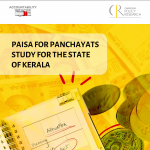
Work Remains Unchanged but the Risk has Increased: Auxiliary Nurse Midwife in Maharashtra
19 May 2020
The ‘Inside Districts’ series launched in April was a one-of-its-kind attempt to capture the experiences of district and Block-level officials, panchayat functionaries and frontline workers, on their challenges and best practices. As India enters the fourth phase of a country-wide lockdown, we went back to some interviewees to understand how their situation has changed. Among them is an Auxiliary Nurse Midwife in Satara, Maharashtra who earlier spoke of the challenge arising from lack of workers for frontlines teams.
Over 33,000 people have been confirmed COVID-19 positive in the state till 18 May 2020, among the highest rates in states. There are only 18,871 registered ANMs in Maharashtra.
The interview was originally conducted in Hindi on 12 May 2020, and has been translated.
Q: What are your tasks now?
ANM: The work has not changed much, but now the risk has increased. People are still coming from outside and we are collecting their information and giving it to the authorities; the number of people we are monitoring has increased. We are home quarantining these people and monitoring them closely along with the ASHA workers.
Apart from this, we are also performing tasks we were performing before the crisis hit like – vaccination, Antenatal Care visits, record-keeping, maintaining the stock of medicine, informing and serving the beneficiaries.
Q: You mentioned the challenge of too few workers for the area that has to be covered. Has this been raised to your seniors? What have they said?
ANM: My area is bigger and is also connected to the city and hence there is a shortage of workers. Generally, there is one ANM for a population of 5,000-10,000 people; however, in my area, there are only two ANMs for 29,000 people, including me. Everyone is aware of this situation, including the Medical Officer, Taluk (Block) Health Officer and District Health Officer, but no one takes any action. When we talk to them about this, they say that they will look at it later because there are not enough workers right now. They motivate us to do our jobs well and the conversation ends there.
Q: Is there anything that you want to share which has helped the team in its work or anything you are proud of?
ANM: All the field workers are doing their jobs very diligently despite increased work hours due to a huge population. ASHA workers are working even on Sundays and holidays, and I am proud of them!
ANMs are village-level female health workers in village Health Sub-centres, and are the first contact person between the community and health services. ANMs are expected to be multi-purpose health workers playing a critical role in maternal and child health including immunisations, family planning services, and treatment of minor injuries and first aid in emergencies and disasters. As per the Rural Health Statistics 2019, there are a total of 2,34,220 ANMs across Sub-centres and Public Health Centres in the country.





